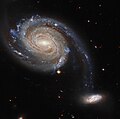Fichier:NGC7752, NGC7753 - HST - Potw2142a.jpg

Taille de cet aperçu : 604 × 600 pixels. Autres résolutions : 242 × 240 pixels | 483 × 480 pixels | 774 × 768 pixels | 1 031 × 1 024 pixels | 2 063 × 2 048 pixels | 3 908 × 3 880 pixels.
Fichier d’origine (3 908 × 3 880 pixels, taille du fichier : 3,2 Mio, type MIME : image/jpeg)
Historique du fichier
Cliquer sur une date et heure pour voir le fichier tel qu'il était à ce moment-là.
| Date et heure | Vignette | Dimensions | Utilisateur | Commentaire | |
|---|---|---|---|---|---|
| actuel | 18 octobre 2021 à 07:11 |  | 3 908 × 3 880 (3,2 Mio) | Fabian RRRR | == {{int:filedesc}} == {{Information |description={{en|1='''Invisible Galactic Gale NGC 4666 takes centre stage in this image from the NASA/ESA Hubble Space Telescope. This majestic spiral galaxy lies about 80 million light-years away in the constellation Virgo, and is undergoing a particularly intense episode of star formation. Astronomers refer to galaxies which are forming stars anomalously quickly as starburst galaxies. NGC 4666’s starburst is thought to be due to gravitational interact... |
Utilisation du fichier
Usage global du fichier
Les autres wikis suivants utilisent ce fichier :
- Utilisation sur ar.wikipedia.org
- Utilisation sur az.wikipedia.org
- Utilisation sur be.wikipedia.org
- Utilisation sur ce.wikipedia.org
- Utilisation sur de.wikipedia.org
- Utilisation sur diq.wikipedia.org
- Utilisation sur en.wikipedia.org
- Utilisation sur eu.wikipedia.org
- Utilisation sur fa.wikipedia.org
- Utilisation sur mg.wikipedia.org
- Utilisation sur mk.wikipedia.org
- Utilisation sur ru.wikipedia.org
- Utilisation sur sk.wikipedia.org
- Utilisation sur tt.wikipedia.org
- Utilisation sur www.wikidata.org